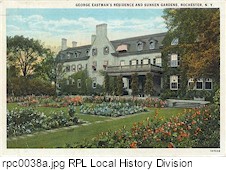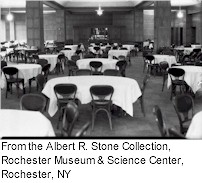From More Lives Than One, by Claude Bragdon, pp.76-79
From the time of his phenomenal rise to fame and fortune up to his death in 1932, George Eastman was the most powerful man in Rochester. He was genuinely and intelligently interested in the affairs of the community in which he had grown up and made his millions, and to its problems he devoted much disinterested labour; but he was a despot, though a benevolent one.
In 1917 Eastman volunteered to provide a new building for the Rochester Chamber of Commerce, and I was chosen to be its architect in collaboration with Messrs. Foster and Gade. In his novel, The Fault of Angels, Paul Horgan puts this highly characteristic speech in the mouth of the character drawn evidently from Eastman: "I am only interested in success." This perhaps accounts for his choice of me, for by that time I was a successful architect. As it was agreed that I should do the planning and designing of the new building, we spent much time together in conference, and though I was never one of his intimates I attended his parties, and he came to dinner at my house. He must have thought well of my ability, because he commissioned me to design an elaborate sunken garden for his East Avenue estate.

(Sunken Garden, George Eastman
House, from Rochester Images)
To certain of life's aspects and issues--aesthetic, philosophic, ethical--Eastman seemed blind, content to accept the opinion of others, professing his own ignorance. But concerning those things which really interested him he was extremely well informed and efficient, a master of clear, straight thinking. A man of steel in an age of steel, a stoic, a slave of duty, in his later years he worked conscientiously at large-scale entertaining, big-game hunting, and other Midian amusements, but there was never any joy in him; he lived a loveless, wifeless, childless existence, its loneliness aggravated rather than mitigated by his enormous wealth.
He had not only the point of view, but the physical appearance of some priest-king of ancient Egypt, and it amuses me to think that he might have been just that, and I his architect, and the Chamber of Commerce building just another temple or tomb. Certainly his attitude toward labour was that of a Pharaoh. I was on the train with him when he was on his way to his first meeting with Henry Ford. He was bitterly opposed to the voluntary paying of high wages by Ford; he regarded it as a betrayal, making it more difficult for other employers of labour to keep the workingman in his place. I had tried to interest Eastman in mobile colour--colour-music--but unsuccessfully. This provoked me into asking him why he had given seven million dollars to the promotion of music, about which he professed to know little; yet he would give nothing toward the development of an abstract art of light, concerning which he knew a great deal. His answer was as frank as it was characteristic: "people need something to keep them happy and contented when they are not engaged in working, and music seems to do just that." In this way I learned from his own lips that his benefactions for the promotion of music were in the nature of insurance against industrial unrest.
Profoundly dissimilar in character and outlook, it was inevitable that Eastman and I should break with one another, though I had for him the greatest liking and respect. The incident which precipitated this rupture was of no great importance; had it not been what it was, it would have been something else. The outstanding feature of the Chamber of Commerce building was a lofty hall, occupying the entire upper floor, wherein a dinner for a thousand people could be served. Here was a great opportunity for an architect. In Venice I had been much impressed by the stately chambers of the Doge's Palace: the walls paneled, without constructed or applied architecture, with decoration of colour and gold in the ceilings and practically nowhere else. I decided to make the room I had to do like that. I submitted the scheme to Eastman and he gave it his approval. I explained that the decoration of the ceiling would be the important matter, and for that reason it should be omitted from the general contract so that we might ourselves select the right man. He saw the point and agreed with me. With this understanding, I made the side walls of paneled oak below and acoustic tile above, without other ornament, and designed the elaborate plaster-work of the ceiling solely with a view to the effect that it would have when done in colour and gold.
When the room was nearly completed, and the plaster ceiling was "in the white", Eastman and I met there by appointment. I reminded him of our former conversation and agreement, and told him that it was now time to let the contract out for the decoration. "How much will it cost?" was his first question. I told him that it would probably cost from five thousand dollars to twenty thousand, the difference depending upon the eminence of the artistic talent employed. He ruminated for some time. "I could give an ambulance to France for five thousand dollars. I like the ceiling just the way it is--I think I'll leave it that way," he finally said.
I was dumbfounded; particularly as I knew how impossible it would be to make him understand the way I felt. "But, Mr. Eastman," I protested. "if I had known that, I would have designed the whole room differently. Colour is now the only thing which will prevent it from looking meager and bare." "There's nothing the matter with the room," he answered, "it's a perfectly good room for the purpose for which it is intended, and what more can anyone ask? You architects are full of expensive notions; engineering is all there is to architecture anyway."
With that he started to walk away, as though he had settled the matter. To my supersensitive ear, what he had just said was little short of blasphemy. I followed him toward the elevator. "Very well, Mr. Eastman," I said, "if that's the way you feel about it, I don't know why you have me for your architect; there are plenty of better engineers. I guess I can't work for you any more."

Dining Room, Chamber of Commerce Building, from the Albert R. Stone
collection, Rochester Images
Eastman had his way about the ceiling, of course, but after the opening dinner, which it was my duty to attend, I never went into the room again. On that occasion Eastman publicly paid me a handsome compliment, but our relation came automatically to an end. Eugenie took my view of the matter, which made the situation easier to bear. Indeed, before that, when she learned that Eastman had planted potatoes, purely as a war-time gesture, in the sunken garden I had designed for him, she said: "Claude, if we starve, you shall never work for that man again."